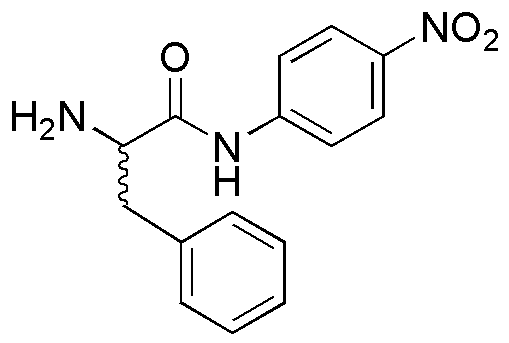DL-Phenylalanine 4-nitroanilide·hydrochloride salt is widely utilized in research focused on:
- Analytical Chemistry: This compound serves as a reagent in various analytical methods, helping researchers detect and quantify amino acids and peptides in biological samples.
- Pharmaceutical Development: It plays a role in drug formulation processes, particularly in developing medications that target neurological disorders, enhancing the efficacy of treatments.
- Biochemical Research: Used in enzyme assays, it aids in studying enzyme kinetics and mechanisms, providing insights into metabolic pathways.
- Material Science: The compound is explored for its potential in synthesizing new materials with specific properties, such as improved thermal stability and conductivity.
- Educational Purposes: It is commonly used in laboratories for teaching purposes, allowing students to understand chemical reactions and analytical techniques in a hands-on environment.
General Information
Properties
Safety and Regulations
Applications
DL-Phenylalanine 4-nitroanilide·hydrochloride salt is widely utilized in research focused on:
- Analytical Chemistry: This compound serves as a reagent in various analytical methods, helping researchers detect and quantify amino acids and peptides in biological samples.
- Pharmaceutical Development: It plays a role in drug formulation processes, particularly in developing medications that target neurological disorders, enhancing the efficacy of treatments.
- Biochemical Research: Used in enzyme assays, it aids in studying enzyme kinetics and mechanisms, providing insights into metabolic pathways.
- Material Science: The compound is explored for its potential in synthesizing new materials with specific properties, such as improved thermal stability and conductivity.
- Educational Purposes: It is commonly used in laboratories for teaching purposes, allowing students to understand chemical reactions and analytical techniques in a hands-on environment.
Documents
Safety Data Sheets (SDS)
The SDS provides comprehensive safety information on handling, storage, and disposal of the product.
Product Specification (PS)
The PS provides a comprehensive breakdown of the product’s properties, including chemical composition, physical state, purity, and storage requirements. It also details acceptable quality ranges and the product's intended applications.
Certificates of Analysis (COA)
Search for Certificates of Analysis (COA) by entering the products Lot Number. Lot and Batch Numbers can be found on a product’s label following the words ‘Lot’ or ‘Batch’.
Número de catálogo
Número de lote/lote
Certificates Of Origin (COO)
This COO confirms the country where the product was manufactured, and also details the materials and components used in it and whether it is derived from natural, synthetic, or other specific sources. This certificate may be required for customs, trade, and regulatory compliance.
Número de catálogo
Número de lote/lote
Safety Data Sheets (SDS)
The SDS provides comprehensive safety information on handling, storage, and disposal of the product.
DownloadProduct Specification (PS)
The PS provides a comprehensive breakdown of the product’s properties, including chemical composition, physical state, purity, and storage requirements. It also details acceptable quality ranges and the product's intended applications.
DownloadCertificates of Analysis (COA)
Search for Certificates of Analysis (COA) by entering the products Lot Number. Lot and Batch Numbers can be found on a product’s label following the words ‘Lot’ or ‘Batch’.
Número de catálogo
Número de lote/lote
Certificates Of Origin (COO)
This COO confirms the country where the product was manufactured, and also details the materials and components used in it and whether it is derived from natural, synthetic, or other specific sources. This certificate may be required for customs, trade, and regulatory compliance.


